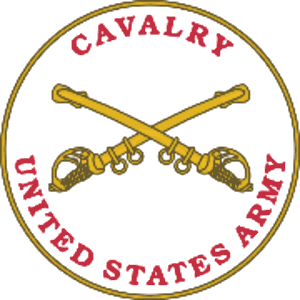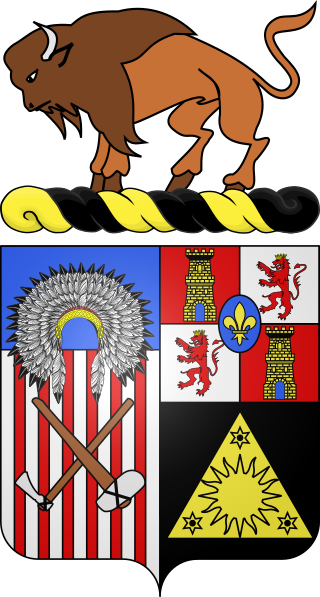A company is a military unit, typically consisting of 100–250 soldiers and usually commanded by a major or a captain. Most companies are formed of three to seven platoons, although the exact number may vary by country, unit type, and structure.

Military ranks are a system of hierarchical relationships, within armed forces, police, intelligence agencies or other institutions organized along military lines. The military rank system defines dominance, authority, and responsibility in a military hierarchy. It incorporates the principles of exercising power and authority into the military chain of command—the succession of commanders superior to subordinates through which command is exercised. The military chain of command constructs an important component for organized collective action.

The 1st Armored Division, nicknamed "Old Ironsides", is a combined arms division of the United States Army. The division is part of III Armored Corps and operates out of Fort Bliss in El Paso, Texas. It was the first armored division of the United States' Army to see battle in World War II. Since World War II, the division has been involved in the Korean War, Cuban Missile Crisis, Persian Gulf War, Iraq, Afghanistan, and several other operations. The division has also received numerous awards and recognition.
Sergeant major is a senior non-commissioned rank or appointment in many militaries around the world.

The VII Army Corps of the United States Army was one of the two principal corps of the United States Army Europe during the Cold War. Activated in 1918 for World War I, it was reactivated for World War II and again during the Cold War. During both World War II and the Cold War it was subordinate to the Seventh Army, or USAREUR and was headquartered at Kelley Barracks in Stuttgart, West Germany, from 1951 until it was redeployed to the US after significant success in the Gulf War in 1991, then inactivated in 1992.

The Distinguished Service Cross (DSC) is the United States Army's second highest military decoration for soldiers who display extraordinary heroism in combat with an armed enemy force. Actions that merit the Distinguished Service Cross must be of such a high degree that they are above those required for all other U.S. combat decorations, but which do not meet the criteria for the Medal of Honor. The Army Distinguished Service Cross is equivalent to the Naval Services' Navy Cross, the Air and Space Forces' Air Force Cross, and the Coast Guard Cross. Prior to the creation of the Air Force Cross in 1960, airmen were awarded the Distinguished Service Cross.

The commanding officer (CO) or commander, or sometimes, if the incumbent is a general officer, commanding general (CG) or general officer commanding (GOC), is the officer in command of a military unit. The commanding officer has ultimate authority over the unit, and is usually given wide latitude to run the unit as they see fit, within the bounds of military law. In this respect, commanding officers have significant responsibilities, duties, and powers.
Chief Warrant officer is a senior warrant officer rank, used in many countries.

The United States Army Quartermaster Corps, formerly the Quartermaster Department, is a sustainment and former combat service support (CSS) branch of the United States Army. It is also one of three U.S. Army logistics branches, the others being the Transportation Corps and the Ordnance Corps.

The 9th Cavalry Regiment is a parent cavalry regiment of the United States Army. It is not related to the 9th Kansas Cavalry Regiment of the Union Army. Historically, it was one of the Army's four segregated African-American regiments and was part of what was known as the Buffalo Soldiers. The regiment saw combat during the Indian and Spanish–American Wars. During Westward Expansion, the regiment provided escort for the early western settlers and maintained peace on the American frontier.
Order of Saint Maurice was established in 1996 in the pattern of the Cavalry & Armor Association's Order of St. George Medallion and is awarded by the National Infantry Association and the certificate is signed by the Chief of Infantry of the United States Army. It is named after Saint Maurice, the leader of the Roman Theban Legion in the 3rd century.
Mustang is a military slang term used in the United States Armed Forces to refer to a commissioned officer who began their career as an enlisted service member. Unlike other nations, a US Mustang Officer is not a temporary or brevet promotion but rather an earned Commission from the President of the United States of America afforded all the same pay command responsibilities and expectations as other commissioned officers in the United States.

Russell Adam Burnham, is an American business owner, Physician Assistant and U.S. Army veteran. Burnham was recognized as the 2003 U.S. Army Soldier of the Year, 2007 U.S. Army Medical Corps NCO of the Year, and is an Eagle Scout. He is the great-grandson of Frederick Russell Burnham (1861–1947), recipient of the Distinguished Service Order, and famous American scout and world-traveling adventurer who helped inspire the founding of the international Scouting Movement.

Cavalry Scout is the job title of someone who has achieved the military occupational specialty of 19D Armored Reconnaissance Specialist in the Combat Arms branch of the United States Army. As with all enlisted soldiers in the United States Cavalry, the person holding the Scout specialization will still be referred to as a "Trooper", the traditional colloquialism denoted in the cavalry's Order of the Spur.

Leon L. Van Autreve was a United States Army soldier who served as the fourth Sergeant Major of the Army. He was sworn in on July 1, 1973, and served until June 1975.

The 10th Cavalry Regiment is a unit of the United States Army. Formed as a segregated African-American unit, the 10th Cavalry was one of the original "Buffalo Soldier" regiments in the post–Civil War Regular Army. It served in combat during the Indian Wars in the western United States, the Spanish–American War in Cuba, Philippine–American War and Mexican Revolution. The regiment was trained as a combat unit but later relegated to non-combat duty and served in that capacity in World War II until its deactivation in 1944.

The United States Army Armor School is a military training school located at Fort Moore, Georgia. Its primary focus is the training of United States Army soldiers, non-commissioned officers, warrant officers, and commissioned officers. It also trains for equipment handling, including the M1 Abrams, the Bradley Fighting Vehicle, and the Stryker Mobile Gun System. The Armor School moved to Fort Benning in 2010 as part of the United States Base Realignment and Closure program.

William Joseph Gainey is a retired United States Army soldier who served as the first Senior Enlisted Advisor to the Chairman of the Joint Chiefs of Staff.
Quartermaster sergeant (QMS) is a class of rank or appointment in some armed forces, especially those of the United Kingdom and the Commonwealth, and formerly also in the United States.

Raymond F. Chandler III is a former United States Army soldier who served as the 14th Sergeant Major of the Army. He was sworn in on March 1, 2011, and active on duty until January 30, 2015. Chandler served in all tank crewman positions and has had multiple tours as a troop, squadron and regimental master gunner. He has served in the 1st Infantry Division (FWD), 2nd Infantry Division, 4th Infantry Division, 1st Cavalry Division, 3rd Armored Division, 2nd Armored Cavalry Regiment, 3rd Armored Cavalry Regiment, United States Army Armor School, and the United States Army Sergeants Major Academy. He also served as first sergeant in four different detachments, troops and companies. As a sergeant major, he served as Operations SGM in 1/2 ACR and as CSM in 1/7 Cavalry, 1st Cavalry Division, United States Army Garrison Fort Leavenworth, Kansas and the United States Army Armor School CSM. Chandler was assigned as the United States Army Sergeants Major Academy CSM in December 2007. In June 2009, Chandler became the 19th Commandant of USASMA and the first enlisted commandant in USASMA history.














